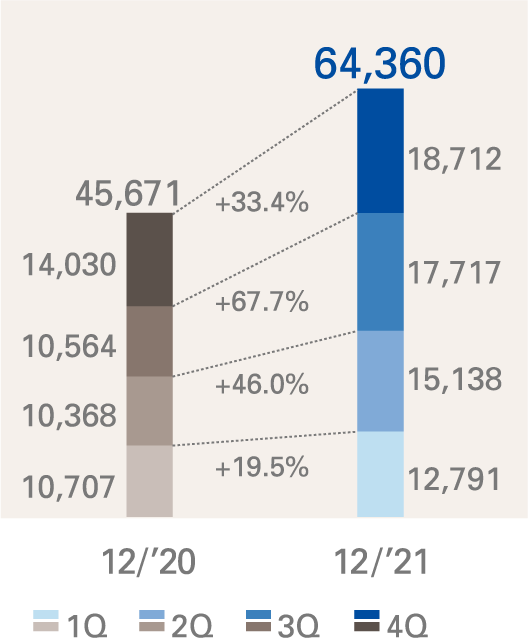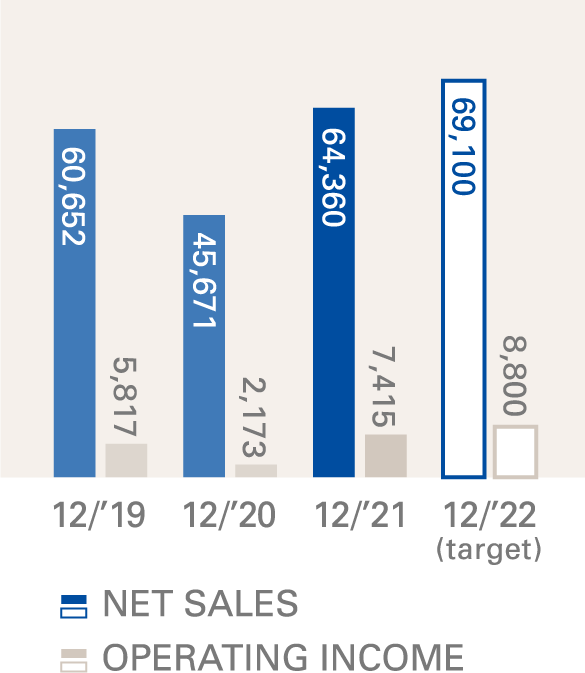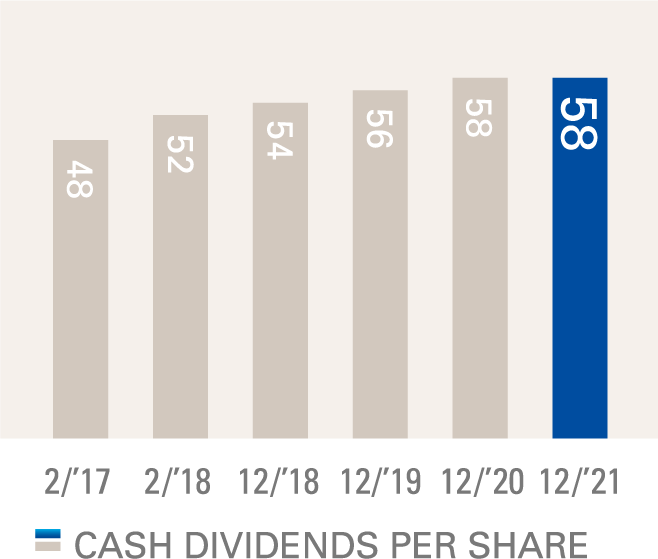Star Micronics ANNUAL REPORT 2021
To Our Shareholders
Mamoru Sato
Representative Director,
President and CEO
Grand Design for a New Age
Despite the ongoing impact of COVID-19, results in both the Machine Tools and Special Products segments were robust in 2021.
Coinciding with the Company’s shift to the Prime Market of the Tokyo Stock Exchange, Star Micronics has put in place a new medium-term management plan in 2022. Guided by this plan, the Star Micronics Group aims to help bring about a sustainable society and enhance corporate value by putting into practice the core concept of the Company and employees growing together and contributing to society.
01Operating Results in 2021
Amid the ongoing impact of COVID-19, economic conditions were affected by a variety of factors including the outbreak of new variants, tight supply of semiconductors and other components, and delays in distribution in 2021. Despite these difficult conditions, the economy in general exhibited a recovery trend due to upswings in vaccination rates across a wide range of countries, the successful implementation of various economic policies, and a host of other factors. In Asia, the Chinese economy generally remained strong. In the U.S. and Europe, economic conditions continued to recover steadily despite concerns surrounding the reemergence and further spread of the virus. Despite some signs of weakness, the Japanese economy also continued to recover. Turning to the major markets in which the Star Micronics Group operates, demand in the mainstay Machine Tools segment increased sharply both in Japan and overseas on the back of the economic recovery worldwide. In this regard, demand for POS printers was especially strong in the U.S.
Under these circumstances, Star Micronics reported sales of ¥64,360 million in 2021, up 40.9% year on year, owing largely to the substantial increase in Machine Tools Segment sales. On the earnings front, operating income jumped 241.3%, to ¥7,415 million, in line with such factors as the substantial increase in sales. Net income attributable to owners of the parent surged 231.5%, to ¥5,740 million.
NET SALES(Millions of yen, %)

02Business Overview
Despite the impact of logistics delays in the U.S. market, sales increased substantially in the Machine Tools Segment owing to robust trends across a wide range of industries as a result of the recovery in overall economic conditions. In Europe, sales grew significantly. This was largely attributable to the recovery in automobile-related sales. As far as Asia is concerned, sales increased substantially. In addition to sustained strong sales of telecommunication-related products in China, this was also due to the recovery in automobile-, medical-, and other-related sales. On the domestic front, sales in Japan grew significantly on the back of robust mainstay automobile-relate and other sales.
Despite the impact of tight component supply and delays in distribution, sales increased substantially in the Special Products Segment. This largely reflected robust food delivery-related sales in the U.S. market. In Europe, sales were strong, especially for large-lot projects. In Japan, sales increased significantly due to strong mPOS demand.

03Outlook for the Following Fiscal Year
With the end of COVID-19 nowhere in sight owing to the incidence of new variants, the outlook for the global economy remains uncertain. This uncertainty is due to a variety of factors including tight supply of semiconductors and other components as a result of the rapid recovery in demand, the sharp rise in resource prices, and the disruption in logistics across various regions. In contrast, the current overall economic recovery is projected to continue owing to the upswing in vaccination rates, the success of stimulus, fiscal, and other measures implemented by each country, and recovery in consumption that had stalled as a result of the pandemic.
Under these circumstances, robust capital expenditure demand is expected to continue both in Japan and overseas. As a result, sales in the mainstay Machine Tools Segment are projected to increase in the next fiscal year. While mPOS demand triggered by the increased use of mobile terminals and food delivery demand resulting from the changes to people’s lifestyles owing to COVID-19 are expected to remain at a high level, sales in the Special Products Segment are anticipated to decline due to the significant impact of tight semiconductor and other component supply.
Based on the aforementioned, and as far as the outlook for consolidated financial results is concerned, sales in the next fiscal year are forecast to reach ¥69.1 billion, up 7.4% compared with the fiscal year under review. From a profit perspective, operating income is projected to climb 18.7%, to ¥8.8 billion, and net income attributable to owners of the parent to grow 11.5%, to ¥6.4 billion.
NET SALES AND
OPERATING INCOME(Millions of yen)

04About the Medium-Term Management Plan
The Star Micronics Group formulated its Medium-Term Management Plan as part of a review of its Corporate Philosophy, Purpose, Management Policy, and Action Guidelines to empower employees to make decisions and act autonomously as we seek to become a company that grows sustainably together with society. At the same time, we formulated a Vision for 2030. (Please refer to pages 10-14 of the Company’s Medium-Term Management Plan for details.)
In order to realize its Vision for 2030, the Company has divided the next nine years into three-year periods. In working toward “building a foundation for change,” “driving change,” and “realizing our vision” over each period, respectively, Star Micronics has formulated the first Medium-Term Management Plan covering the three years from 2022 to 2024. Issues to be addressed are presented as follows.
Positioning the mPOS and food delivery markets as a principal area of operations, the Star Micronics Group will work to further expand sales of printers and other products while at the same time refining software technologies in a bid to continue providing new value to customers. Through these means, the Group will endeavor to become a total solution provider for store operations in the Specialty Products Segment.
In the Machine Tools Segment, the Group will strengthen the production system in Thailand and China, position the Kikugawa Factory as a sustainable factory that nurtures people, develops technology, and grows together with society and promote large-scale renovation in order to meet robust demand for facilities and equipment. At the same time, steps will be taken to delve deeper into hardware technologies and adopt software technologies, and to further cement the Group’s position as a leading manufacturer of automatic lathes.
As far as new business is concerned, the Group will focus on uncovering opportunities in the three production DX, store DX, and logistics DX domains while aiming to construct a new business model mainly through M&As.
From a Group-wide perspective, energies will be directed toward strengthening the management platform, reforming human resource systems that allow employees to maximize their potential, and constructing R&D structures and systems to continuously create proprietary technologies, while moving forward with initiatives to address material issues based on the Sustainability Policy.
05Corporate Governance and Shareholder Returns
The Board of Directors of the Company consists of three internal directors and four outside directors, and thus the outside directors already account for the majority. Star Micronics has also put in place a non-mandatory Nomination and Compensation Committee as an advisory body to the Board of Directors to enhance the transparency and objectivity of procedures related to the nomination and compensation of directors and executive officers and to further enhance corporate governance.
Star Micronics positions the return and distribution of profits to stakeholders as an important management priority. The Company’s basic policy is to take into consideration the consolidated shareholders’ dividend on equity (DOE) ratio based on a consolidated total payout ratio of at least 50%, including the repurchase of its own shares. Based on this policy, the decision was made to pay a fiscal period-end dividend of ¥29 per share at the end of the fiscal year under review. As a result, including the ¥29 interim dividend, the annual dividend for the fiscal year came to ¥58.
With regard to its shareholder return policy for the future, Star Micronics has decided to target a consolidated total payout ratio of at least 50%, including the repurchase of its own shares, with the aim of paying a stable annual dividend of at least ¥60 per share. Based on this policy, plans are in place to pay an annual dividend of ¥60 per share for the following fiscal year (¥30 per share for each of the interim and fiscal year-end dividends), up ¥2 per share compared with the fiscal year under review.
In working toward achieving its established goals, the Star Micronics Group kindly requests the continued support and understanding of all stakeholders.
March 2022
Mamoru Sato
Representative Director,
President and CEO
CASH DIVIDENDS
PER SHARE(Yen)

